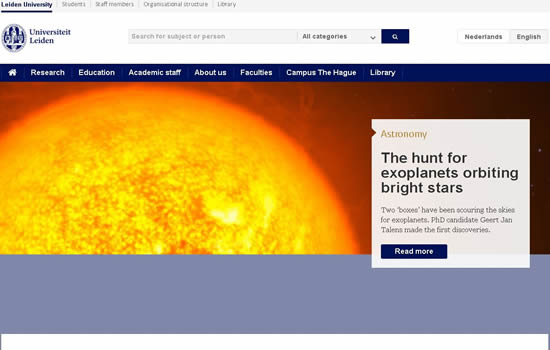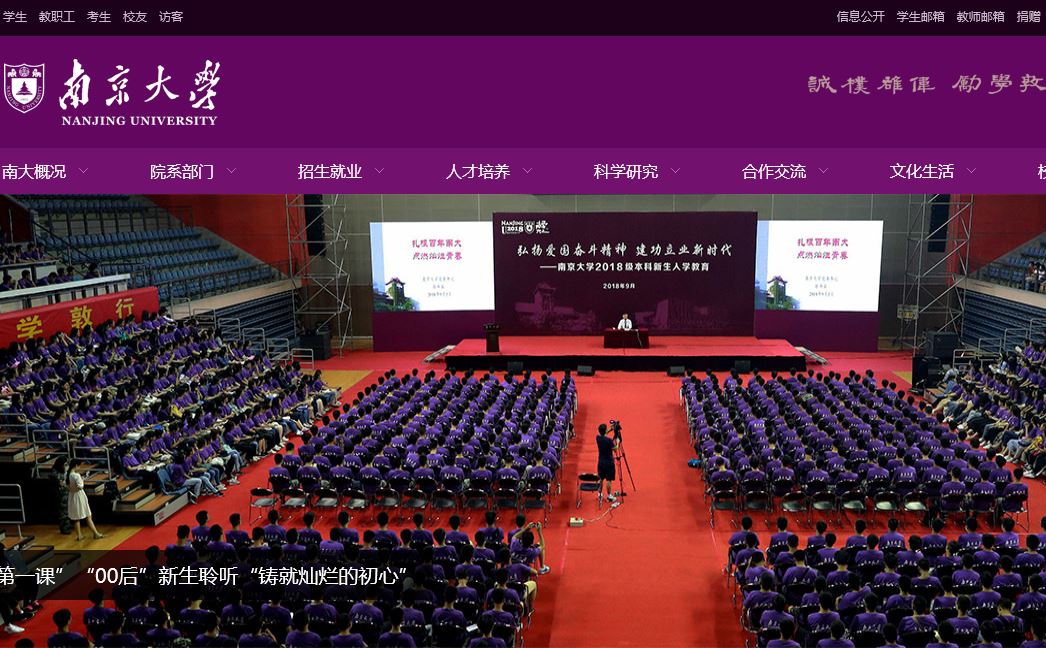选择热点
 荷兰莱顿大学
荷兰莱顿大学 西班牙巴塞罗那大学
西班牙巴塞罗那大学 巴西圣保罗大学 University of Sao Paulo, Brazil
巴西圣保罗大学 University of Sao Paulo, Brazil 台湾南华大学 University of South China in Taiwan
台湾南华大学 University of South China in Taiwan 科技大学 National University of Defense Technology
科技大学 National University of Defense Technology 南京大学 Nanjing University
南京大学 Nanjing University 上海复旦大学 Fudan University
上海复旦大学 Fudan University 泗水大学(Ubaya)
泗水大学(Ubaya) 印尼大学 universitas indonesia
印尼大学 universitas indonesia 越南某大学 Vietnam National University
越南某大学 Vietnam National University 菲律宾大学 University Of The Philippines
菲律宾大学 University Of The Philippines
为何美剧总在秋季首映
发布时间:2025-01-06
来源:大学网站
There are practical reasons for networks to release new programming in the fall, but you might be surprised to find out one of the main reasons has nothing to do with any promotional considerations, planning, or even television itself; it was about giving the radio industry a chance to get out of New York City during the summer.
出于某些实际原因,一些节目、电视剧总在秋季回归,但你会意外地发现这几乎与任何宣传计划都无关,甚至与电视剧本身的内容也无关。
这仅是为了给夏季的广播业一个冲出”纽约的机会。
CBS and NBC originally began as radio networks, and back in the 1920s and 1930s before television, their headquarters in New York City produced most national radio programming.
But as New Yorkers know, there are few things more unbearable than a New York City heat wave, and before the invention of air conditioning, beating the heat meant getting out of the city.
It only made sense to shut down radio production and give people a chance to escape to Cape Cod bungalows and Catskill retreats to wait out the long hot summer.
CBS和NBC最初是作为广播公司发家的。
早在20世纪20年代和30年代电视节目流行之前,他们就在位于纽约的总部涵盖了国家大部分的广播节目。
但每一个纽约人都知道,没有谁能捱得过纽约夏季的热浪。
在空调发明之前,唯一能躲过此劫的办法就是离开纽约。
这时候叫停广播业,给人们一个机会去科德角或者卡茨基尔避暑的机会,也说得过去。
But then television came along.
Back in the late '40s and early '50s, television was just beginning to really take off.
TV had clearly been on the rise before World War II, but once war broke out, the government shut down commercial broadcasts and television equipment production.
Hardly anyone was working in television during the war, but the post-war economic boom of the late '40s that followed made TV sets affordable for middle-class families, and the demand for new programming was at an all-time high.
但是电视出现了。
早在40年代末和50年代初,电视业就开始真正腾飞了。
在第二次世界大战前,它开始兴起,但是战争爆发,政府就停止了商业广播和电视设备的生产。
在战争期间,几乎没有人从事与电视相关的工作,但40年代末——即战后的经济繁荣期,中产阶级家庭都买得起电视机了,新节目的需求量达到历史最高水平。
Broadcast networks knew they had a gold mine on their hands if they could satisfy that demand, but television was a new medium and it wasn't clear what people wanted to see.
The easiest thing to do was to produce new shows by offering TV contracts to existing radio celebrities, and many early hits like "The Adventures of Ozzie and Harriet"and "The Red Skelton Show" were developed by giving radio stars their own television programs.
Everyone making the switch from radio to TV made sure their schedules allowed them to spend the summer months elsewhere, and networks continued taking breaks after May and premiering new shows in September when everyone was back from vacation.
广播界心知肚明,一旦能满足这种增长的需求,他们就能赚的盆满钵满。
但在当时,电视机是作为一种新媒体的身份出现的,它能否为大众所接受是未知的。
最简单的方式就是和广播名人签署合同,让他们出新节目;还有一些早期很红的如 奥兹和哈里特的冒险 和 雷德·斯克尔顿秀 ,都是一些广播明星主持的节目。
为了能在夏日避暑,每个人的注意力从广播转向了电视。
而广播业也可以在五月到九月这段时间轮休,等到人们度假结束,新的节目也就出来了。
When television production moved to California, the tradition of starting new blocks of shows in the fall continued, and as it turns out, the system worked well for the industry—and for viewers.
It still does to this day.
Fewer people tend to watch TV during the summer since they are vacationing or spending more time watching summer movies.
So releasing new shows in the fall ensures the networks free buzz around the annual season premieres and guarantees viewers know when to tune in to their favorite shows' new seasons.
当电视业重心从纽约转移到加州时,秋季回归的这一传统也被保留了下来,而事实也证明,此套不成文的规定,对业界和观众都很受用。
现在,也仍是这样。
夏季很少有人还看电视,因为他们大都选择出去旅游了。
所以,在秋季发布新剧,既让电视业能缓一缓,观众也准确地知道了何时该收看、收听他们最爱的节目了。
But it's also about advertising dollars.
Networks sell advertising cyclically.
The upcoming TV season's schedule is revealed when the previous season ends so advertisers can buy slots months in advance—a system that began in the 1960s.
Many think this way of selling ads is obsolete and should be replaced.
Who knows, maybe fall premieres will become obsolete one day, as well.
Many networks are already experimenting with releasing new shows in the spring and even in the summer.
但这么做也与利益相关,因为这样广播网就可以周期地赚广告费了。
前一季一结束,节目更新时间一确定,广告商就有机可乘了——利用这段间隔期插播广告。
此现象也是从60年代开始的。
很多人认为这种销售方式已经过时了,理应被取代。
但是谁也说不准,或许有一天秋季首映/回归”也会被取代呢。
毕竟现在,已经有广播公尝试在冬季甚至是夏季更新节目了。
点击查看更多 美剧推荐【为何美剧总在秋季首映查看网站:[db:时间]】
出于某些实际原因,一些节目、电视剧总在秋季回归,但你会意外地发现这几乎与任何宣传计划都无关,甚至与电视剧本身的内容也无关。
这仅是为了给夏季的广播业一个冲出”纽约的机会。
CBS and NBC originally began as radio networks, and back in the 1920s and 1930s before television, their headquarters in New York City produced most national radio programming.
But as New Yorkers know, there are few things more unbearable than a New York City heat wave, and before the invention of air conditioning, beating the heat meant getting out of the city.
It only made sense to shut down radio production and give people a chance to escape to Cape Cod bungalows and Catskill retreats to wait out the long hot summer.
CBS和NBC最初是作为广播公司发家的。
早在20世纪20年代和30年代电视节目流行之前,他们就在位于纽约的总部涵盖了国家大部分的广播节目。
但每一个纽约人都知道,没有谁能捱得过纽约夏季的热浪。
在空调发明之前,唯一能躲过此劫的办法就是离开纽约。
这时候叫停广播业,给人们一个机会去科德角或者卡茨基尔避暑的机会,也说得过去。
But then television came along.
Back in the late '40s and early '50s, television was just beginning to really take off.
TV had clearly been on the rise before World War II, but once war broke out, the government shut down commercial broadcasts and television equipment production.
Hardly anyone was working in television during the war, but the post-war economic boom of the late '40s that followed made TV sets affordable for middle-class families, and the demand for new programming was at an all-time high.
但是电视出现了。
早在40年代末和50年代初,电视业就开始真正腾飞了。
在第二次世界大战前,它开始兴起,但是战争爆发,政府就停止了商业广播和电视设备的生产。
在战争期间,几乎没有人从事与电视相关的工作,但40年代末——即战后的经济繁荣期,中产阶级家庭都买得起电视机了,新节目的需求量达到历史最高水平。
Broadcast networks knew they had a gold mine on their hands if they could satisfy that demand, but television was a new medium and it wasn't clear what people wanted to see.
The easiest thing to do was to produce new shows by offering TV contracts to existing radio celebrities, and many early hits like "The Adventures of Ozzie and Harriet"and "The Red Skelton Show" were developed by giving radio stars their own television programs.
Everyone making the switch from radio to TV made sure their schedules allowed them to spend the summer months elsewhere, and networks continued taking breaks after May and premiering new shows in September when everyone was back from vacation.
广播界心知肚明,一旦能满足这种增长的需求,他们就能赚的盆满钵满。
但在当时,电视机是作为一种新媒体的身份出现的,它能否为大众所接受是未知的。
最简单的方式就是和广播名人签署合同,让他们出新节目;还有一些早期很红的如 奥兹和哈里特的冒险 和 雷德·斯克尔顿秀 ,都是一些广播明星主持的节目。
为了能在夏日避暑,每个人的注意力从广播转向了电视。
而广播业也可以在五月到九月这段时间轮休,等到人们度假结束,新的节目也就出来了。
When television production moved to California, the tradition of starting new blocks of shows in the fall continued, and as it turns out, the system worked well for the industry—and for viewers.
It still does to this day.
Fewer people tend to watch TV during the summer since they are vacationing or spending more time watching summer movies.
So releasing new shows in the fall ensures the networks free buzz around the annual season premieres and guarantees viewers know when to tune in to their favorite shows' new seasons.
当电视业重心从纽约转移到加州时,秋季回归的这一传统也被保留了下来,而事实也证明,此套不成文的规定,对业界和观众都很受用。
现在,也仍是这样。
夏季很少有人还看电视,因为他们大都选择出去旅游了。
所以,在秋季发布新剧,既让电视业能缓一缓,观众也准确地知道了何时该收看、收听他们最爱的节目了。
But it's also about advertising dollars.
Networks sell advertising cyclically.
The upcoming TV season's schedule is revealed when the previous season ends so advertisers can buy slots months in advance—a system that began in the 1960s.
Many think this way of selling ads is obsolete and should be replaced.
Who knows, maybe fall premieres will become obsolete one day, as well.
Many networks are already experimenting with releasing new shows in the spring and even in the summer.
但这么做也与利益相关,因为这样广播网就可以周期地赚广告费了。
前一季一结束,节目更新时间一确定,广告商就有机可乘了——利用这段间隔期插播广告。
此现象也是从60年代开始的。
很多人认为这种销售方式已经过时了,理应被取代。
但是谁也说不准,或许有一天秋季首映/回归”也会被取代呢。
毕竟现在,已经有广播公尝试在冬季甚至是夏季更新节目了。
点击查看更多 美剧推荐【为何美剧总在秋季首映查看网站:[db:时间]】
- 上一篇: 三八女神特辑:权力女神 希拉里·黛安·罗德姆·克林顿
- 下一篇: 红海行动 展现中国英雄本色
相关阅读
目录列表
资讯列表
英语资讯


共0条评论
网友评论温馨提示:您的评论需要经过审核才能显示,请文明发言!